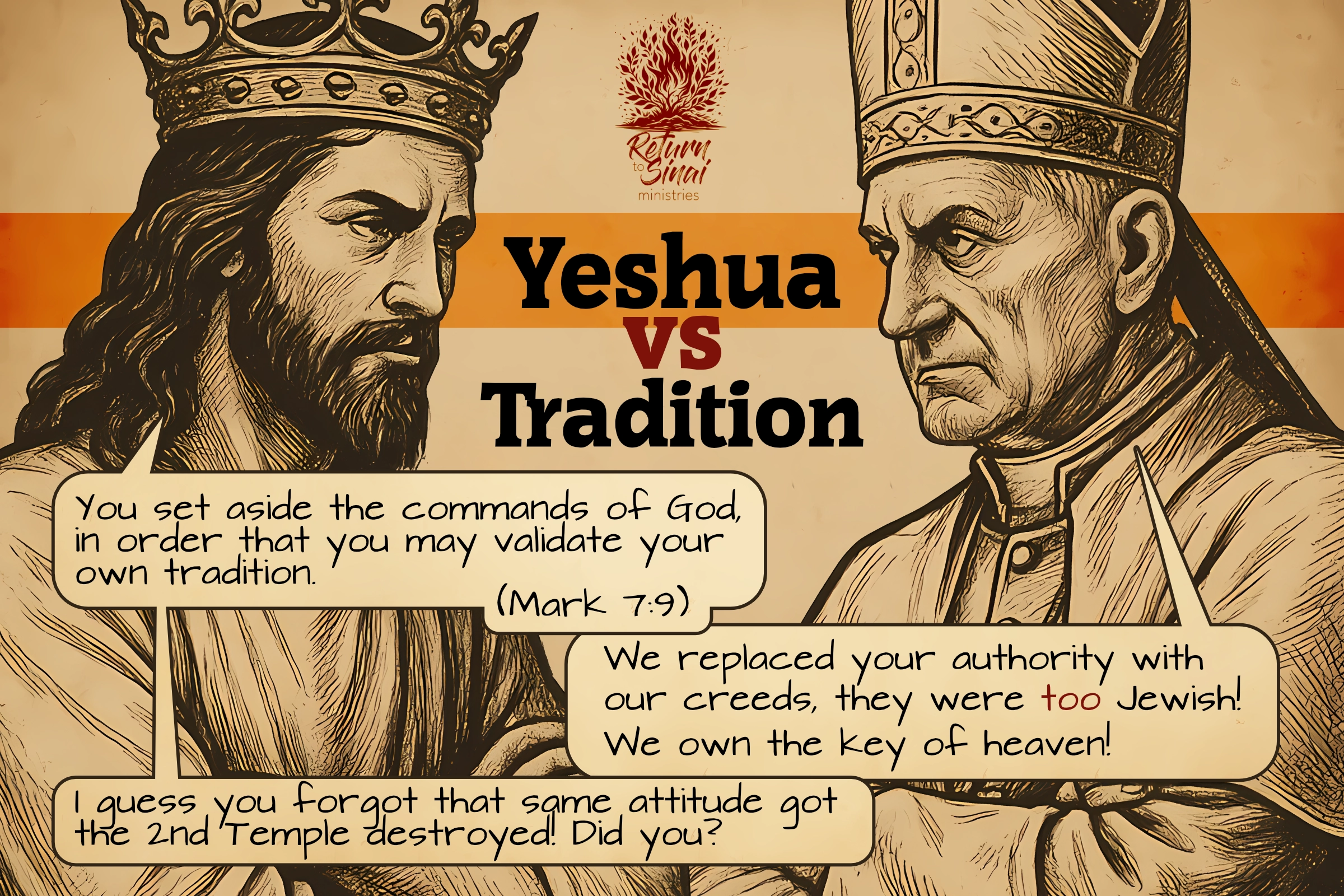Comparison Guide: Yeshua’s Teachings vs. Church Traditions
This guide contrasts the teachings and practices of Yeshua (Jesus) with the commonly practiced traditions in modern Christianity, highlighting key differences in worship, doctrine, and daily living.
1. Law (Torah)
- Yeshua’s Teaching: Affirmed the Torah’s ongoing validity (Matthew 5:17–19).
- Church Tradition: Often taught the Law was fulfilled and abolished.
2. Sabbath
- Yeshua’s Teaching: Kept and honored the 7th day Sabbath (Luke 4:16; Mark 2:27).
- Church Tradition: Sunday worship based on resurrection tradition.
3. Biblical Feasts
- Yeshua’s Teaching: Celebrated Passover, Unleavened Bread, and Sukkot (John 7:2; Luke 22:15).
- Church Tradition: Easter and Christmas celebrated instead.
4. Prayer
- Yeshua’s Teaching: Prayed directly to the Father (Matthew 6:9).
- Church Tradition: In some traditions, prayer is directed to Mary or saints.
5. Worship
- Yeshua’s Teaching: Worship in spirit and truth, not limited to temples or rituals (John 4:23–24).
- Church Tradition: Institutionalized worship with rituals and liturgies in specific buildings.
6. Dietary Instructions
- Yeshua’s Teaching: Ate clean foods per Leviticus 11; never declared all foods clean (Acts 10:14).
- Church Tradition: Often teaches all foods are now clean.
7. Use of Images
- Yeshua’s Teaching: Honored the 2nd commandment — no carved images (Exodus 20:4–6).
- Church Tradition: Use of statues, icons, and crucifixes in worship.
8. Leadership Model
- Yeshua’s Teaching: Emphasized servant leadership, not hierarchy (Matthew 23:8–11).
- Church Tradition: Hierarchical leadership (e.g., pope, bishops, pastors).
9. Tithing / Giving
- Yeshua’s Teaching: Focused on justice, mercy, and faith over ritual tithing (Matthew 23:23).
- Church Tradition: Emphasis on monetary tithing to the church.
10. Salvation
- Yeshua’s Teaching: Salvation by grace through faith, confirmed by obedience (John 14:15).
- Church Tradition: Often taught as grace alone without responsibility to obey.
11. Baptism
- Yeshua’s Teaching: Full immersion after repentance (Matthew 3:13–17).
- Church Tradition: Infant baptism or sprinkling common in many traditions.
12. God’s Name
- Yeshua’s Teaching: Revealed and honored the Father’s name (John 17:6, 26).
- Church Tradition: Replaced God’s name with titles like “Lord” or “God”.
13. Identity of Disciples
- Yeshua’s Teaching: Disciples known by obedience and love (John 13:35).
- Church Tradition: Identity often based on church membership or denomination.
Key Themes Yeshua Emphasized
- Obedience and inner transformation (Matthew 7:21–23)
- Returning to Scripture over tradition (Matthew 15:3, 9)
- Worshiping in Spirit and Truth (John 4:23)
- Walking in the Father’s commandments (John 15:10)
Why Does This Matter?
Understanding the difference between what Yeshua taught and what’s practiced today is essential for:
- Re-aligning your faith with the original, biblical model
- Avoiding man-made traditions that conflict with Scripture
- Walking in truth and freedom as Yeshua intended (John 8:31–32)
Summary
Yeshua called His followers to truth, obedience, and spiritual authenticity. Over time, many church traditions replaced or obscured these teachings. Returning to the foundations He set helps align our walk more closely with Yahweh’s Word.
Resources
Comparison Guide: Yeshua’s Teachings vs. Church Traditions – [Table format]
| Topic | Yeshua’s Teaching / Practice (Biblical Texts) | Common Church Teaching / Practice | Comment |
|---|---|---|---|
| Law (Torah) | Affirmed Torah’s ongoing validity (Matthew 5:17-19) | Often taught the Law was fulfilled and abolished | Misreads “fulfilled” as “ended” Yeshua upheld the Torah |
| Sabbath | Kept and honored the 7th day Sabbath (Luke 4:16; Mark 2:27) | Sunday worship based on resurrection tradition | No biblical command to change the Sabbath |
| Biblical Feasts | Celebrated Passover, Unleavened Bread, Sukkot (John 7:2; Luke 22:15) | Easter and Christmas celebrated instead | Biblical feasts replaced by holidays with pagan roots |
| Prayer | Taught to pray to the Father directly (Matthew 6:9) | Some pray to Mary or saints (Catholic, Orthodox) | Yeshua emphasized direct access to the Father |
| Worship | Worship in spirit and truth, not place or form (John 4:23-24) | Ritualized worship in buildings with fixed liturgies | Worship became institutionalized, less relational |
| Dietary Instructions | Ate clean foods (Lev. 11), never nullified food laws (Acts 10:14) | “All foods clean” doctrine used to ignore Leviticus 11 | Misunderstood texts lead to rejection of God’s food laws |
| Use of Images | No use of images, upheld the 2nd commandment (Ex. 20:4-6) | Statues, crucifixes, icons used in worship | Especially in Catholicism and Orthodoxy |
| Leadership Model | Servant leadership, no hierarchy (Matthew 23:8-11) | Hierarchical clergy (pope, bishops, pastors) | Original model was plural elders, Spirit-led |
| Tithing / Giving | Emphasized justice and mercy over ritual tithing (Matthew 23:23) | Focus on financial tithing to churches | Biblical tithing was agricultural and helped the poor |
| Salvation | By grace through faith, confirmed by obedience (John 14:15) | Often taught as grace alone with no obligation to obey | Obedience is seen as “legalism” though Yeshua commands it |
| Baptism | Full immersion after repentance (Matthew 3:13-17) | Infant baptism or sprinkling in many traditions | Baptism in Scripture follows conscious faith |
| God’s Name | Revealed and honored the Father’s name (John 17:6, 26) | Replaced with “Lord” or “God” in most Bibles | Name ”Yahweh” and “Yeshua” often removed or altered |
| Identity of Disciples | Followers were known by their obedience and love (John 13:35) | Identity often based on church membership or denomination | Yeshua defined disciples by lifestyle, not labels |

Leave a Reply